- English
- About Giving
- Donation History
History of Support for Nagoya University
A University supported by the local community
Nagoya University has developed with great support from the local community. That support started in the period of the University’s predecessor school, founded in 1871 (Meiji 4). Donations from local residents supported the establishment of higher educational institutes in the area such as the Medical School, Medical College, the Eighth Higher School, and the Nagoya College of Commerce.
When Nagoya Imperial University was founded in 1939 (Showa 14), Aichi Prefecture donated the entire amount required to establish the University, which was a huge amount equivalent to about 20% of the total expenditure of the Prefectural general account at that time. In addition, the site of the Higashiyama Campus with an area of about 161,000 tsubo (about 532,200 ㎡) was also provided free of charge by many landowners to the University at the time of establishment.
After that, a large amount of donations have been given to the University in the form of money, securities, and properties (such as buildings) by many private companies and individuals. These donations have helped the University recover from the damages of World War II and become a core university in Japan, as well as one of the world's leading research universities, while contributing to the sustainable development of local communities. The few examples indicated below are only a portion of the large amount of donations that the university has received.
In 2006, Nagoya University Foundation was established.
Donations that are given to this Foundation will be used as scholarships to support students, resulting in the development of courageous intellectuals who will lead the next generation.
Major donations to Nagoya University
(since the Nagoya Imperial University was established)
-
1939
- Donation for construction of Nagoya Imperial University and donation of Higashiyama Site
-
 Local newspaper reporting that the Higashiyama site was determined to be Nagoya Imperial University's property (1939)
Local newspaper reporting that the Higashiyama site was determined to be Nagoya Imperial University's property (1939)The current Higashiyama Campus is originally a site donated free of charge by many local landowners when Nagoya Imperial University was established in 1939. While there were candidate sites including the former site of the abandoned Yada River and Narumi-cho, Aichi-gun, the site near Higashiyama area with an area of about 470,000 ㎡ was donated to Aichi Prefecture by the Land Reallocation Association. After that, negotiations with neighboring individual landowners continued, and in January 1948, land with a total area of about 530,000 ㎡ gathered by Aichi Prefecture was finally donated to the state government, and the Higashiyama Campus duly became the site of the Nagoya University.
-
1943
- University Hospital Branch building (Mutsuda Building)
-
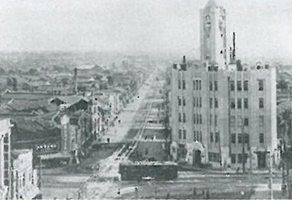 Mutsuda Building donated by Mr. Sho Mutsuda in 1943 (right)
Mutsuda Building donated by Mr. Sho Mutsuda in 1943 (right)Currently, Nagoya University Hospital has no branch organization, but since the reformation of the University (from Imperial University to University) in May 1949 until 1996, it had a branch hospital. The predecessor of the branch was the Nagoya Imperial University Hospital Branch, which used the land and building (Mutsuda Building) in Shinsakaemachi 3-chome, Naka Ward (currently Sakae 4-chome, Naka Ward) in Nagoya City. The land and building were donated to the University by Mr. Sho Mutsuda in May 1943.
-
1947
- School of Medicine Reconstruction Expenses (Temporal School Building Construction)
-
The School of Medicine of Nagoya Imperial University lost almost all of Tsurumai's school buildings and about half of its affiliated hospital's building due to the air raid in 1945. As it was impossible to resume education and research activities immediately after the damages, at the end of 1945, the School of Medicine borrowed the Showa-Jukudo building located in Shiroyama-cho, Chikusa Ward, Nagoya City to start classes. Reconstruction of the Tsurumai area was not easy in the turmoil after the war, but the reconstruction supporters' association organized under the School of Medicine Alumni Association raised funds between 1947 and 1950. Then, wooden mortar-painted laboratories and lecture rooms were successfully built, although they were still temporary buildings. At the same time, the Tsurumai Campus, of which facilities and functions had relocated to many places, started to be gradually reconstructed.
-
1949
- The New Nagoya University Started
-
The conversion from Nagoya Imperial University to Nagoya University due to the education system reformation in 1949 is one of the biggest breakthroughs in the history of the University, along with another reformation to a national university corporation in 2004. Nagoya University was founded during the wartime when higher education institutes went through twists and turns while being tossed about by GHQ and the state government. Under such conditions, the University had only three schools (medicine, science, and engineering), so it had difficulty becoming a genuine comprehensive university, with many different schools. However, the School of Letters and the School of Law and Economics were founded in September 1948 and the School of Education was founded at the same time as the new reformed University was started in 1949 by incorporating the Eighth Higher School, Nagoya College of Economics, and Okazaki Higher Normal School. This amalgamation led to Nagoya University becoming a comprehensive university comprised of six schools.
Schools and Departments of liberal arts, excluding the Department of Economics and the Department of Business Administration of School of Economics, borrowed the former barracks of the 6th Infantry Regiment (Imperial Japanese Army) in Ninomaru, Nagoya Castle, Minamisotobori-cho, Naka Ward, Nagoya. It was an old barrack. Though it was repaired and repainted, there was a draft, and when someone walked down its corridor, it made noise. As such, the University was in some difficult situations in terms of equipment, but there was an open exchange between instructors and students across departments and majors. In 1965, Building No. 3 of the School of Letters was relocated to the Meiji Mura, an architectural museum in Inuyama City, Aichi Prefecture. However, the building was renovated to resemble the appearance of a building used as a barracks in the Meiji era. Therefore, we unfortunately cannot see the remnants of the School of Letters Building No. 3.
-
1951
- Expenses for construction and land acquisition for the School of Agriculture (Anjo area)
-
To have a School of Agriculture, many training and experimental facilities, including farms, are indispensable. Nagoya University was struggling to secure such sufficient facilities and land. When the University was faced with a difficult situation, Anjo Town (now Anjo City), which was called "Denmark in Japan," offered to provide facilities and land. In the early days of the period in which the School of Agriculture had its facilities and farms in Anjo Town, sports and English conversation were popular in that area. People used the term "Anjo family" to represent the strong bonds among people in the area. This land was then donated to Anjo City and the School's farm has been relocated to Togo Village, Aichi District (currently Togo Town).
-
1960
- Toyoda Auditorium
-
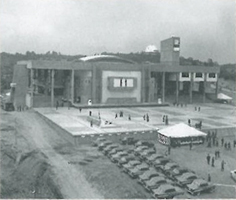 Toyoda Auditorium on the day of the completion ceremony (provided by the Nagoya Times Archives Committee)
Toyoda Auditorium on the day of the completion ceremony (provided by the Nagoya Times Archives Committee)Toyoda Auditorium (designed by Fumihiko Maki, who won the 1962 Architectural Institute of Japan [AIJ] Prize), one of the symbols of Nagoya University, was donated by the Toyota Motor Industry Corporation (currently known as the Toyota Motor Corporation) in 1960. The auditorium was named to commemorate the late Sakichi Toyoda, the inventor of the Toyoda Automatic Looms, which is famously known as being the origin of the Toyota Motor Corporation. From the beginning of the founding of Nagoya Imperial University, the University had an idea to construct an auditorium and library with donations from the local community. However, the idea was not realized until the latter half of the 1950s, when Taizo Ishida, President of Toyota Motor Industry Corporation accepted the request by Seizo Katsunuma, the third President of the University, during the development of the Higashiyama Campus. Currently, there is a bust of Dr. Katsunuma within the Toyoda Auditorium. A grand completion ceremony was held in May 1960. President Ishida expressed his eager wish that the Toyoda Auditorium, full of the spirits of the pioneers of the Toyoda family, would contribute to the promotion of education and the development of science. In the following month, from June 3rd to 6th, the 1st Nagoya University Festival was held with Toyoda Auditorium as the main venue, which became the symbolic center of Nagoya University. The Festival gathered existing cultural and sports festivals organized by each School at the dispersed campuses.
-
1963
- University Headquarters Building in Higashiyama Campus
-
Nagoya University, which had been called an "octopod University," because the University's facilities were dispersed across the region, successfully gathered many dispersed facilities on the Higashiyama Campus from 1963 to 1964. The Nagoya University headquarters that was in the Meijo Campus completed its relocation to Higashiyama in March 1964. The new headquarters location was located on the east side of the Toyoda Auditorium in order to facilitate management of the Toyoda Auditorium, the convenience of using the conference room, and topographical reasons. The current headquarters building No. 2 is the one constructed at this time (1964). Since then, the building has had the characteristic H-shape when viewed from above. The headquarters building then was constructed and donated by the Nagoya University Maintenance Supporters Association, organized by Aichi Prefecture, Nagoya City, and the Nagoya Chamber of Commerce and Industry as well as other members. The relocation expenses for the Schools of Letters and Education were also supported by the Association. As seen here, Nagoya University has developed with great support and expectations from the local community.
-
1964
- Furukawa Library (now Furukawa Hall)
-
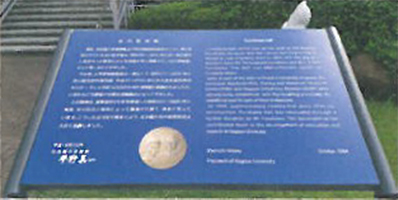 A plate that is installed in front of the entrance of Furukawa Hall and explains the Hall including donations by Mr. and Mrs. Furukawa
A plate that is installed in front of the entrance of Furukawa Hall and explains the Hall including donations by Mr. and Mrs. FurukawaFurukawa Hall, which is situated southwest of the Toyoda Auditorium on the Higashiyama Campus, was completed in 1964. The building is named after the late Mr. Tamesaburo Furukawa (founder of Nippon Herald Film Co., Ltd.) and his wife Mrs. Shima Furukawa, who donated to the construction of the Library. Since Nagoya Imperial University was established, there was already a plan to build a new library on the Higashiyama campus with donations from local public and private entities, but its construction was extremely difficult due to the turmoil during and after World War II. As the development of Higashiyama Campus progressed, with the donation by Mr. and Mrs. Furukawa, a library named the Furukawa Library was finally built. The Library was designed by Yoshiro Taniguchi, a professor at Tokyo Institute of Technology, with a three-story structure that looks like a two-story building, and an atrium layout that is designed to be spacious and long in the east-west direction. The design is said to have considered the inclination of the Green Belt that runs parallel to the Library and the vastness of the Green Belt in the east-west direction. After the completion of the new Central Library in 1981, its library function was relocated to the new building. Then, the former Furukawa Library became the Furukawa Research Museum and is now called Furukawa Hall, which houses the Nagoya University Museum.
-
1987
- The Science Research Promotion Fund and Grants-in-Aid for Scientific Research
-
1990
- The Science Research Promotion Fund
-
1992
- Symposion
-
The Symposion is a three-story complex with a conference room (Symposion Hall), a restaurant, a tea lounge, laboratory rooms, etc. It was completed and opened in 1992. It was constructed as part of a project of 1989 to commemorate the 50th anniversary of the University. In addition to the construction of the memorial facility, the anniversary project included the compilation and publication of the history of Nagoya University and the establishment of an academic exchange foundation. The Symposion was built and donated by the Nagoya University 50th Anniversary Commemorative Project Supporters Association (the Association's first Chairman was Mr. Kotaro Takeda, President of the Nagoya Chamber of Commerce and Industry), an off-campus organization of the University established in 1987. The building was named after the Greek word "symposion," which means feast, participants of a feast, and a room or venue where a feast is held, which was deemed to be suitable for the venue for academic exchange including presentations of academic research results.
-
1993
- Information Plaza
-
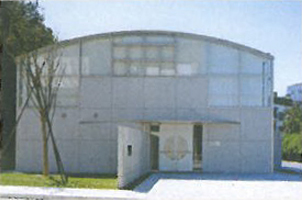 Information Plaza (1993)
Information Plaza (1993)In 1993, the University of Nagoya Press donated to the construction of the Nagoya University Information Plaza as part of support measures to strengthen the University's information dissemination and information service functions, which was one of the issues of the University reformation at that time. The Information Plaza is a facility that comprehensively communicates the University's latest scientific research outcomes and research-related information to the public, applicants for admission, etc. It serves as the University's base for collaborations with the society and as a communication hub, still being widely used today.
-
2004
- Facilities for extracurricular activities
-
2005
- Facilities for extracurricular activities
-
2007
- Complete renovation and extension of Toyoda Auditorium
-
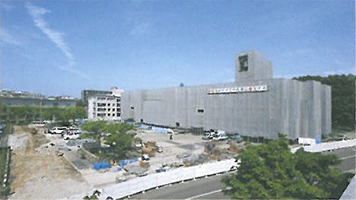 Complete renovations of Toyoda Auditorium with donations from Toyota Motor Corporation and Toyota Group companies (completed in 2007)
Complete renovations of Toyoda Auditorium with donations from Toyota Motor Corporation and Toyota Group companies (completed in 2007)In 2007, the Toyoda Auditorium was completely renovated and expanded with the donations from Toyota Motor Corporation and Toyota Group companies. Forty-seven years after the initial construction, architect Fumihiko Maki was again in charge of the design of the major renovation of the Auditorium. After graduating from the Faculty of Engineering at the University of Tokyo in 1952, Mr. Maki studied at Harvard University Graduate School and then became an assistant professor at the University of Washington. Then, in 1958, as a member of the Graham Foundation, he set out on a world trip for a two-year architectural tour; during that tour he designed the Toyoda Auditorium. Toyoda Auditorium was Mr. Fumihiko Maki's debut work. This work was very successful, making him Japan's leading architect who won the 1962 AIJ Prize. Through this renovation, the Auditorium's internal facilities were updated and the building was seismically retrofitted. On the other hand, the exterior design was maintained and restored because the Auditorium has been widely recognized as one of Japan's representative modern architectures. The Toyoda Auditorium is designed with a symbolic shape of "门," which is a simplified kanji character meaning "a gate." As Nagoya University does not actually have a main gate, the symbolic shape of the Auditorium is a conceptual symbol of the University's gate.
-
2010
- Donation to the University in the form of securities Land for dormitory for international students
-
2016
- Establishment of Hoshizaki Scholarship with donations to support students (in the form of securities)
-
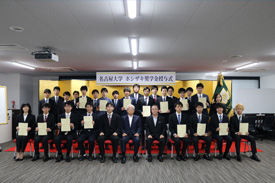 Hoshizaki Scholarship Conferral Ceremony (2019)
Hoshizaki Scholarship Conferral Ceremony (2019)Nagoya University has set up the Hoshizaki Scholarship with donated shares of the Sakamoto Donation Foundation Corporation, which was established by the Chairman & CEO of Hoshizaki Corporation. (a food service equipment manufacturer) and his wife. The Hoshizaki Scholarship provides a grant-type scholarship to students in need of financial assistance based on the intention of Mr. and Mrs. Sakamoto who hope to "support prospective students that want to learn about manufacturing."
-
2017
- Gender Research Library
-
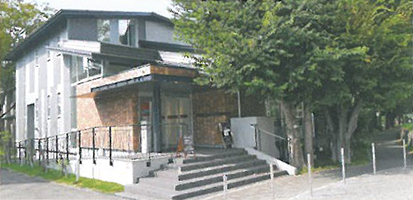 Gender Research Library
Gender Research LibraryThe Gender Research Library was built along Yamate Green Road on the south side of the Higashiyama Campus with donations from charitable persons. Built for the purpose of practically developing studies on gender, the two-story steel-framed building with a floor area of 840 ㎡ is a research activity facility equipped with a library space that can store up to 40,000 books, an archive room, a reading room, an exhibition corner, research rooms, lecture rooms, and a cafe space.
-
2018
- Donations to support researchers (in the form of securities)
-
2020
- Okuma Machine Tool Engineering Building
-
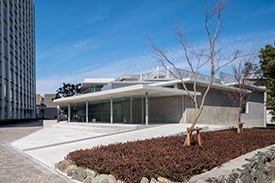 Okuma Machine Tool Engineering Building (2020)
Okuma Machine Tool Engineering Building (2020)Okuma Corporation, headquartered in Oguchi-cho, Niwa-gun, Aichi Prefecture, is one of Japan's leading machine tool manufacturers. The Corporation started with Okuma Noodle Machine Co., which was established by Eiichi Okuma in Nagoya in 1898. In April 2020, with a donation from the Corporation, the Okuma Machine Tool Engineering Building celebrated its completion in the Higashiyama Campus. The bond between the Corporation and Nagoya University dates back to 1939. The Corporation and Nagoya University have conducted joint research projects and established scholarships, and the Corporation has given donations to the University for supporting research projects. To date, many graduates of the University have been employed by the Corporation.
Such a close bond between us has resulted in the establishment of the Okuma Machine Tool Engineering Donation Course in 2015, which then led to the donation of this Engineering Museum.
